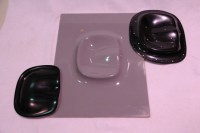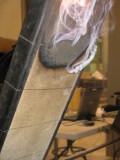Local Canoe Manufacturer Receives Timely Assistance
 Although large aerospace and ground transportation industry projects and biocomposites feature strongly in the Composites Innovation Centre’s (CIC) activities there is still room for small companies to receive our support. Having problems with a seat component, a local wood strip canoe manufacturer Big Dipper Canoe Works, contacted the CIC to see how we could be of assistance. Recognizing the need for improved stiffness coupled with a reliable process, a resin infusion moulded part was quickly conceived. Starting with an original seat component, reinforcements were added together with run offs to produce a realistic reverse plug. Traditional polyester tooling materials and methods were then used to fabricate a master pattern and subsequent mould. A one piece resin infusion mat containing a flow medium was combined with a resin infusion process consisting of temporary bagging materials to produce the part. “Being able to reverse engineer the seat within a very short period that resulted in a very high quality production ready part was really impressive”, stated Nolan Iezzi of Big Dipper. The resin infusion technology is now in the process of being transferred to the manufacturer thus improving their capabilities and product offerings. For further information on Big Dipper Canoe Works, please contact their website at: www.bigdippercanoeworks.com
Although large aerospace and ground transportation industry projects and biocomposites feature strongly in the Composites Innovation Centre’s (CIC) activities there is still room for small companies to receive our support. Having problems with a seat component, a local wood strip canoe manufacturer Big Dipper Canoe Works, contacted the CIC to see how we could be of assistance. Recognizing the need for improved stiffness coupled with a reliable process, a resin infusion moulded part was quickly conceived. Starting with an original seat component, reinforcements were added together with run offs to produce a realistic reverse plug. Traditional polyester tooling materials and methods were then used to fabricate a master pattern and subsequent mould. A one piece resin infusion mat containing a flow medium was combined with a resin infusion process consisting of temporary bagging materials to produce the part. “Being able to reverse engineer the seat within a very short period that resulted in a very high quality production ready part was really impressive”, stated Nolan Iezzi of Big Dipper. The resin infusion technology is now in the process of being transferred to the manufacturer thus improving their capabilities and product offerings. For further information on Big Dipper Canoe Works, please contact their website at: www.bigdippercanoeworks.com
Making Biocomposites Less Flammable
 With farmers having a tendency to burn flax residues to get rid of them in the field, it is only natural that there are concerns regarding their fire resistance when combined as reinforcements in composite bus parts. As part of the Composites Innovation Centre’s (CIC) ongoing biocomposites development activities, an assessment of various fire retardant methodologies was performed. Several alternate fire retardant approaches were assessed that included gel coats, surface veils and additives. The additives selected consisted of aluminium trihydrate, borates, brominates and phosphorus. The ASTM E162 flame spread index test was used as an indication of performance comparing the results to North American bus regulations; a maximum radiant panel index of 35 being the critical value. Several panels were produced using the resin infusion process with manufacturing performance monitored such as resin flow, gel time, degree of cure and resin shrinkage. The panels were tested and the brominate additive was found to be the most successful followed by the phosphorus fillers; however, this latter combination did negatively inhibit the curing performance of the resin. The flame retardant gel coat and veils were also found to be effective but only when combined with resin filled aluminum trihydrate. For further information, please contact: cic@ecopoxy.com
With farmers having a tendency to burn flax residues to get rid of them in the field, it is only natural that there are concerns regarding their fire resistance when combined as reinforcements in composite bus parts. As part of the Composites Innovation Centre’s (CIC) ongoing biocomposites development activities, an assessment of various fire retardant methodologies was performed. Several alternate fire retardant approaches were assessed that included gel coats, surface veils and additives. The additives selected consisted of aluminium trihydrate, borates, brominates and phosphorus. The ASTM E162 flame spread index test was used as an indication of performance comparing the results to North American bus regulations; a maximum radiant panel index of 35 being the critical value. Several panels were produced using the resin infusion process with manufacturing performance monitored such as resin flow, gel time, degree of cure and resin shrinkage. The panels were tested and the brominate additive was found to be the most successful followed by the phosphorus fillers; however, this latter combination did negatively inhibit the curing performance of the resin. The flame retardant gel coat and veils were also found to be effective but only when combined with resin filled aluminum trihydrate. For further information, please contact: cic@ecopoxy.com
